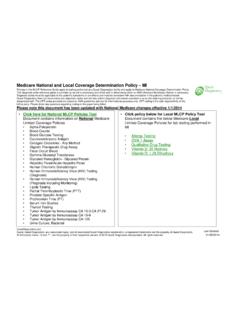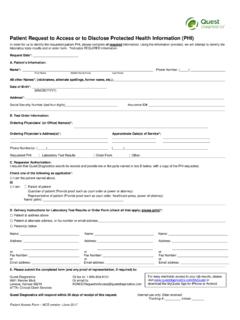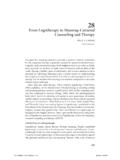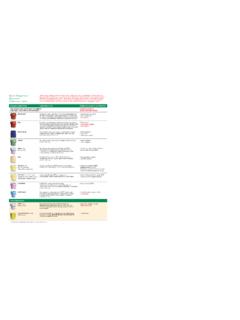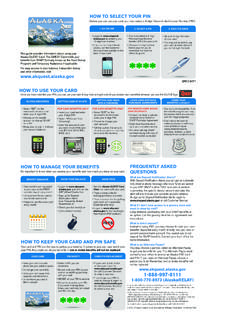Transcription of 444 Real-time Deepwater Current Profiling Syst - …
1 Real-time Deepwater Current Profiling System Michael Vogel, Shell Global Solutions (US). Darryl Symonds, RD Instruments Ning Xiao, LinkQuest Inc. Tim Cook, Flotation Technologies, Inc. Charles Abbott, Evans-Hamilton, Inc. Abstract-A problem for the offshore oil and gas industry is Presently, the maximum Profiling range is about 1200m obtaining complete Real-time Current profiles in water depths with a single RD Instruments (RDI) Ocean Surveyor meter. greater than 1200m, the present maximum range of a single RD Shell is presently operating and exploring in water depths Instruments Acoustic Doppler Current Profiler (ADCP) meter. greater than this range. To increase the vertical Profiling Increasing commercial activity in those depths and the desire to coverage, Shell Global Solutions (US) has worked with RDI, further understand deep ocean processes drives this need. A. solution that implements a two-meter system utilizing LinkQuest, Inc.
2 , Evans-Hamilton, Inc., and Flotation underwater acoustic modems was developed. The study tested a Technologies, Inc. in developing a multi-meter Real-time dual-meter system that integrated surface and bottom mounted Current measurement system. The system employs ADCP systems. The challenges addressed were uncertain LinkQuest, Inc. underwater acoustic modems to transmit the performance of the modems and the ADCPs due to the noisy data from a bottom mounted ADCP to the surface in real underwater acoustic environment and a potential lack of deep time . Deploying an upward looking bottom mounted meter water acoustic backscattering. The significant advantage of a has the advantage of optimizing the acoustic signal by Real-time data acquisition system is providing operational applying the greatest power in the region of lowest guidance for the rig activities and the ability to control the backscattering. system in effort to optimize Profiling range and performance.
3 I. INTRODUCTION A prototype system was successfully tested last year in 900m water depth using a 300kHz RDI Workhorse (WH). Shell Oil Company and other offshore commercial Sentinel. The result was 100% accurate data transmission. A. operators typically collect oceanographic data and deployment at a 1574m water depth drilling site with a meteorological data from their platforms. There are many bottom mounted RDI 75kHz WH Long Ranger in mid-July reasons for ocean Current data acquisition by the oil and gas 2001 explored not only the data transmission reliability, but industry. Some are: also the back-scattering environment in the deep ocean. II. PRIOR STUDIES. Measurements help improve our understanding of ocean processes and further process model Recent deep data taken in the Gulf of Mexico with 75kHz development. ADCPs indicate that there may be a dearth of effective Ocean Current criteria for structural design are based backscattering at depths greater than 1500m for low on rare events.
4 These events are better represented frequency acoustic Doppler measurements. Deployments of in databases comprising extensive measurements. downward-looking low frequency ADCP meters mounted at Operational needs for Real-time Current information mid-column in deep water have achieved extremely include: platform installation, rig orientation, riser diminished Profiling range. and tubular deployment/recovery, remotely operated Since deep water currents are of great interest to scientists vehicle (ROV) operation, estimation of potential around the world, a technique was developed to acquire deep component fatigue, identification of ocean Current Current profiles. Starting in 1988, ADCPs were mounted process, and work boat station-keeping. onto CTD rosette packages and were used to collect profile Measuring Current profiles from offshore rigs using ADCPs data as the system is lowered through the water column. The helps satisfy many of these needs.
5 Profile data collected while the rosette is lowered is combined and a single full ocean profile is constructed. Recent analysis of observations of significant deep ocean currents, as observed in 2000m waters near the Sigsbee RDI has worked with these scientists to analyze the Escarpment in the Gulf of Mexico by Texas A&M collected data. The data analyzed has shown a very University, has increased industry concern over presence of repeatable trend in the backscatter concentration in the water previously unknown, strong deep flows [1]. It has been at depths. Water depths greater than 1500m show a suggested that bottom intensified barotropic topographic significant drop in the concentration of backscatter at depths Rossby waves are the source of these relatively unknown between 900-1100m, (from customer reviewed data at RDI, processes [2]. 1998-2000). The data analyzed also show that when the water depth is greater than 2000m, the backscatter below MTS-0-933957-28-9 1.
6 1100m can be so small as to reduce the Profiling range of a system by up to 60% for ADCPs at a 300kHz frequency. To facilitate the ability to communicate and change the ADCPs at 150kHz have lost as much as 80% of their setup of the WH Long Ranger, a set of LinkQuest acoustic Profiling range at depths below 1100m due to the reduced modems were used. LinkQuest Inc. manufactures high-speed backscatter. underwater acoustic modems that combine recent advances in high-speed digital communication, such as Digital Subscriber Tests performed in the Gulf of Mexico with a Broad Band Line and cellular communication, with broadband underwater (BB) 75kHz ADCP (a system capable of collecting 400-500m acoustics. Tailored for various ocean environments, these of range in depths above 1000m) mounted at 1500m of depth modems achieve a high data rate, robustness and low power in 3000m of water were unable to obtain more than 40m of consumption. A bit error rate of less than 10 7 has been range [3].
7 The data showed that the backscatter was so low consistently observed in the field [5]. that little to no reflected energy was received by the ADCP. At the end of 1999, LinkQuest Inc. worked with Shell Dr. Tim Boyd of Oregon State University conducted a Global Solutions (US) and Evans-Hamilton, Inc. to deploy a study with a WH Long Ranger 75kHz off of the coast of set of their UWM2000 modems in the Gulf of Mexico in Oregon in 2700m of water. His results showed that when the high-noise offshore drilling environment. From 3 November meter was deployed in approximately 1400m water depth, to 19 December 1999, LinkQuest's UWM2000 acoustic different maximum Profiling ranges were possible, depending modem was deployed with a 300kHz RDI Workhorse ADCP. on if the system was mounted upward or downward facing. at 900m below sea surface from an actively drilling platform. When upward facing ranges of up to 600m were possible. While data were transmitted through the acoustic link in real - When the deployment was changed to downward facing, time at 9600 baud, the ADCP recorder was also used.
8 By ranges were reduced to 400m [4]. comparing the logged Current ensembles at the surface PC, obtained through the acoustic link, and the Current ensembles Another test by Dr. Boyd used the same WH Long Ranger in the ADCP recorder, it is concluded that there was no loss 75kHz deployed upward looking off of the coast of Hawaii. of any Current ensemble and no error in the data [5]. The In 1447m of water, the Profiling ranges varied from 600m at success of the deployment prompted Shell to adopt night to less than 300m in the day. Associated with this LinkQuest's Deepwater UWM4000 modems for this 1600m change were large changes in the returned signal strength in test on the Deepwater Nautilus. The UWM4000 modem the profile. This change is presumed to be caused from the reaches 4000m in range and rates up to 4800 bits/second in migration of plankton even at these depths. standard mode and 9600 bits/second in optional mode. The modem operates at a frequency band centered on 17kHz.
9 It was thought that using the WH Long Ranger 75kHz at a depth of nearly 1600m presented the possibility that the range Floatation Technologies, Inc. developed a sub-surface of the system may be reduced so that quality data would not deployment buoy that held the RDI WH Long Ranger ADCP. be obtained. However, by mounting the ADCP upward and the LinkQuest UWM4000 acoustic modem. Flotation facing (thus pointing into the area of the strongest Technologies' Flotec-3000 low-density syntactic foam backscatter), and the ability of manipulating the ADCP provides the buoyancy component of the buoy package. This configuration in Real-time using the underwater acoustic material is designed for years of continuous service at 3000m modems, a reasonable amount of range could be obtained. depth. The remaining materials are constructed from either Type 316 stainless steel or titanium for minimum corrosion III. INSTRUMENTATION over extended deployments and all dissimilar metals are isolated to prevent galvanic corrosion.
10 Shell Oil Company is performing drilling operations from the Transocean Sedco Forex Deepwater Nautilus platform in This buoy was designed to house an RDI WH Long the Gulf of Mexico in 1574m of water. The platform is Ranger ADCP in either the upward or downward facing equipped with an RDI BB VM75kHz ADCP. This BB direction and to house a LinkQuest acoustic modem and ADCP is mounted in the port pontoon of the platform and is external battery pack. The buoy measuring 40 inches in sitting approximately 9 meters below the surface. This diameter has a positive buoyancy of approximately 200 lbs. system is providing real time data for the top 500 meters of with the RD WH Long Ranger and LinkQuest Modem and water. External Battery cases loaded. Based on this positive buoyancy and the currents expected in the area, Flotation An upward looking RDI WH Long Ranger 75kHz ADCP Technologies recommended a 600 lb anchoring weight. This was mounted at the bottom of the sea floor to measure the is 3 times the positive buoyancy of the assembly, and was lower portion of the water column.
